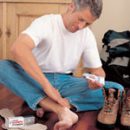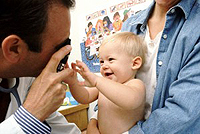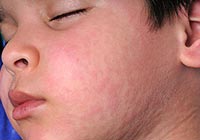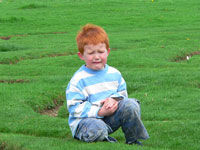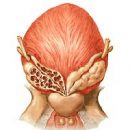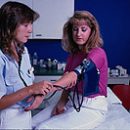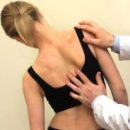What are the symptoms of Rakhita? What are the basic principles of the treatment of rickets? How to assign vitamin d to a child? Answers to these questions you will find in the article.
Content
Question number 1. Why do children get rickets?
These are toxicosis of pregnant women, non-compliance with the rules of hygiene, insufficient stay of the child in the air.
Rickets more often occurs with artificial feeding and in premature babies. Frequent ORVI and pneumonia, dystrophy, liver and kidney lesion play. Important importance and bad conditions of the medium, departure (lack of light, air, dampness, crowding, small use of sun rays).
Question # 2. What are the symptoms of the I and II degree of Rakhit?
In the clinic distinguish 3 severity of Rakhita.
Rakhit 1 degree is characterized by changes in the nervous system: irritability appear, shuddering in a dream, sweating, itching, baldness. From the side of the bone system of deviations is insignificant, there may be softening and compliance of the edges of the large spring.
At the II degree suffer nervous, bone, muscular system. Signs of changes in the nervous system are more pronounced, the child is late in motor development, muscle hypotension is detected. Especially with Rakhit 2 degrees, bone changes are pronounced: an increase in the size of a large spring, the foolishness of its edges, seams, rib «beads», «Bangles» on hands. Anemia develops, changes from the respiratory and cardiovascular systems appear, the size of the liver and spleen increases. There is a delay in the length of the length, the teeth will be broken later, signs of osteo-porn appear.
Question number 3. What are the symptoms of the III degrees of Rahita?
With III degree of Rakhit, the above symptoms are exacerbated. The head acquires a square shape, the bridge, the nipper of the solid grotty, the bite is incorrect, the deformation of the chest is observed («Chicken breasts» and «chest of shoemaker»), «Night pearls», curvature of the shoulder bones, laying the pelvis and the narrowing of the entrance to the small pelvis, the curvature of the legs and the spine (kyphosis, scoliosis, lordosis) as a result of bone lesion. The hypotension of the muscles and the ligament apparatus is enhanced, which leads to the breakdown of the joints, the appearance «frog» Belly, flatopy. Children with a delay start to sit, stand, walk. Anemia is growing, the size of the liver and spleen increases, respiratory and cardiovascular system suffer. This leads to the fact that the emerging pneumonia proceed is heavier, often recurnected, go to a protracted and chronic course.
Question number 4. What are the symptoms of rickets depending on its period?
There are 4 districts of the disease: the initial, height of the disease, reconvalue, residual phenomena.
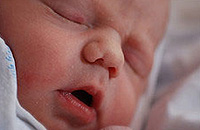
The initial period lasts 2-3 weeks and is more often observed in children of 2-3 months of age, and in premature 2-3 weeks after birth. During the rank of illness, almost all organs and systems are involved in the process, but the symptoms of bone lesions are dominated by.
During the reconvaluation period, the process subsides, the symptoms of the disease decrease, which is the result of the treatment or staying in the air in the spring-summer period.
Residual phenomena in the form of bone changes may be maintained for many years, if the treatment of Rakhit I and III degrees was carried out inadequate.
Question number 5. What are the symptoms of rickets depending on the nature of its flow?
By the nature of the flow, the sharp, subacute, recurrent rickets.
The acute course of the disease is more likely to have premature and in children aged before. The first plan in the clinic is the signs of softening bones and osteoporosis. With a subacute course, there is an increase in frontal and dark bugs, «beads», «Bangles», «Night pearls». The recurrent course is characterized by a refund of the disease after the improvement period. Most often, this is due to inadequate treatment, impaired care and nutrition, layering of other diseases.
Question number 6. How to treat Rakhit?
Rachet treatment should be complex, individual depending on the degree of severity, flow, period and sensitivity to vitamin D. All children need full nutrition balanced by proteins, fats and carbohydrates. More this requirements are breastfeeding. Proper sleep and wake mode, maximum stay in air, massage, gymnastics, clothing, suitable weather, are necessary for the successful treatment of rickets. Specific treatment of Rakhita is carried out by vitamin D2.
Question number 7. How to take vitamin D?
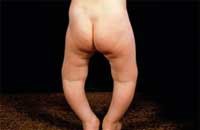
With Rahute I degrees, vitamin is scheduled for 2-4 thousand. ME per day for 4-6 weeks, term dose 120-1 180 thousand.
With Rahute II degree vitamin D2, 4-6 thousand is appointed. ME per day for 4-6 weeks, term dose - 180-270 thousand.
In case of rickets III, vitamin D2 is assigned to 8-12 thousand. MB per day for 6-8 weeks, term dose 400-700 thousand.
After 10-15 days of treatment with vitamin D2, it is necessary to investigate the blood for calcium content and conduct a sample of Sulkovich. With a sharply positive reaction and with raising calcium levels in the blood, vitamin D2 is canceled. For children over 3 months with rickets of II-III degrees, instead of appropriate vitamin D2, you can conduct a course of treatment of UFO (10-12 sessions), starting with 1/4 biodesis and gradually raising to 2.5-3 biodezes on irradiation.
The course of specific therapy during the year should not be repeated. After it, transitions to supporting therapy with preventive doses - 400 me per day.
Question number 8. And what else will help?
With rickets II-III degrees to improve muscle tone, you can assign age doses of prozero-on and ATP to 12-15 injections intramuscularly. The introduction of age doses of vitamins A, vitamins of the group B, with.
After 2-4 weeks, the positive dynamics of clinical, laboratory and radiographic data occurs with the usual Rakhit. In the absence of such dynamics, the diagnosis must be clarified.
Children over 4-5 months shown conifer baths (1/2 tablespoons of coniferous extract on water bucket for 5-10 minutes, for course - 15-20 baths). Pastomian children older than 5 months are prescribed salted baths (100 g of salts on 1 bucket of water). Water temperature 36-37 °C, the duration of salt baths is 3-5 minutes, it is better to do them every other day, for a course of treatment 10-15 baths.
With pronounced skeletal defects, an orthopedic consultation is required.
Question number 9. How to carry out the prevention of rickets?
Specific prophylaxis of rickets is carried out from 3-4 weeks. The best method of prevention - «fractional», T. E. Daily dacha vitamin D at a dose of 100-400 me. The daily need of children in vitamin D is 100 me, but, depending on the different conditions, it can be increased to 400 me. This dose of vitamin D is recommended to give children during the first year daily, excluding the summer period.
It is allowed to prevent rickets by the method «Tolls», When Vitamin D gives a child once a week - at once 3.5 thousand meters, and so throughout the year, excluding the summer period. This method is worse «fractional» and applied in cases where Vitamin D is forced to give a child a nurse (with adverse social factors or mothers negligence).
Children over 3 months living in the north is prescribed by HFO every other day, 8-10 procedures, starting with 1/2 or 1/4 to 2.5 biodesis. Before conducting UFO, vitamin D is canceled and assigned again after the end of the UFO course.


